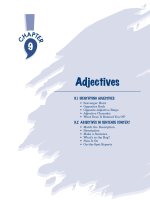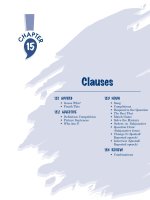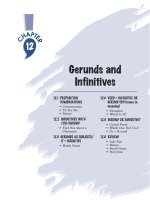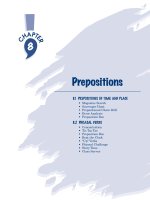fun With Grammar - Gerunds and Infinitives
Bạn đang xem bản rút gọn của tài liệu. Xem và tải ngay bản đầy đủ của tài liệu tại đây (322.78 KB, 24 trang )
12.1 PREPOSITION
COMBINATIONS
• Concentration
• Tic Tac Toe
• Relays
12.2 INFINITIVES WITH
TOO/ENOUGH
• Find Out About a
Classmate
12.3 GERUNDS AS SUBJECTS/
IT
+ INFINITIVE
• Match Game
12.4 VERB + INFINITIVE OR
GERUND (Difference in
meaning)
• Examples
• Which Is It?
12.5 GERUND OR INFINITIVE?
• Coctail Party
• Which One Do I Use?
• Go + Gerund
12.6 REVIEW
• Line-Ups
• Relays
• Board Game
• Storytime
Gerunds and
Infinitives
12
227
12.1 PREPOSITION COMBINATIONS
1. CONCENTRATION
Materials:
Board and chalk or markers
Dynamic:
Groups
Time:
20 minutes
Procedure:
1. Draw a blank grid on the board with just the numbers in the
spaces. Prepare a concentration grid with all words filled in for
your use. Below is a possible example. Some prepositions will have
to be repeated.
2. Divide the class into groups of four or five. The groups take turns
calling out two numbers as they try to make a match. As they call
out the numbers, write the corresponding word in the appropriate
square on the board. If they make a match, give the group a point
and cross out the two words, but leave them on the board. If the
words are not a match, erase the words and go to the next group.
When a group makes a match, it gets an extra turn.
3. When all matches have been made, the group with the most points
wins.
NOTE: The groups can discuss among themselves the numbers they
want to call out, but cannot write down any numbers and words.
Although they can talk together, you will accept an answer only
from the student in the group you call upon.
2. TIC TAC TOE
Materials:
Board and chalk or markers
Worksheet 71 for variation game
Dynamic:
Teams
Time:
10 minutes
Procedure:
1. Draw a tic tac toe grid on the board and fill in verbs or expressions
that take prepositions, as indicated on the next page. Divide the
class into two teams.
1 interested 2 on 3 apologized 4 insist 5 for
6 to 7 afraid 8 thank you 9 instead 10 about
11 for 12 excited 13 in 14 start 15 in
16 of 17 to 18 accustomed 19 fool 20 of
be used stop me be responsible
insist be capable look forward
object talk be remembered
2. The object is to fill in the preposition that follows each verb. A
player on the first team goes to the board and fills in the word in
the square of his/her choice, then sits down. The first player from
the opposing team goes to the board. He/she has the choice of
either completing another word or correcting what he/she thinks is
someone else’s incorrect completion. The first team with three
correct answers in a row, any direction, is the winner.
Variation:
Divide the class into groups of three. You can become the third person
in a group of two, or, if one student is left over, make one team of four.
Two students are the players in a group of three, and the third
student is the judge, who may have his/her grammar book open to the
list of preposition combinations. He/she decides if a player has filled in
the correct word. (In a group of four there are two judges.) Distribute
one worksheet to each group.
After the first game, the students change roles so the judge becomes a
player. Continue until all students have had a chance to be the judge.
3. RELAYS
Materials:
Board and chalk or markers
Dynamic:
Teams
Time:
10 minutes
Procedure:
1. On the board, make lists of verbs and/or expressions that require a
preposition. The two lists include the same words, but are
arranged in different order.
Example: interested responsible
dream insist
apologize apologize
believe interested
crazy worry
responsible dream
worry believe
insist crazy
2. Divide the students into two teams and have them line up on
either side of the board. One member from each team comes to the
board and adds the correct preposition to one of the words on the
board. The students then quickly pass their chalk to the next
228
229
student in line. Succeeding players can either choose another word
to add a preposition to or correct any incorrect answer written by
one of his/her teammates.
3. The first team to finish the list with all answers correct is the
winner.
12.2 INFINITIVES WITH
TOO/ENOUGH
1. FIND OUT ABOUT A CLASSMATE
Materials:
Worksheet 72 or similar 3”x5” cards
Dynamic:
Whole class
Time:
20 minutes
Procedure:
1. Cut Worksheet 72 into cards and fill in the name of a student from
the class in each blank, or make similar cards. Distribute a card to
each student, making sure that he/she does not receive the card
with his/her own name on it.
2. Each student finds the classmate whose name is in the question
on his/her card. The students ask and receive an answer to their
questions and respond to the question being asked of them by the
classmate who has the card with their name on it. (This will most
likely not be the same person. Carlos may have the card with
Rosa’s name on it, while Rosa has the card with Young’s name on
it. This means Rosa will have to answer Carlos’ question and ask
Young a question.)
Example card: What is Keiko too short to do?
Student A asks Keiko: What are you too short to do?
Keiko’s answer: I am too short to play basketball.
3. If they question another student but no one has asked a question
of them, they should sit down and wait for a classmate to approach
them with a question. This will avoid too much congestion in the
classroom. If you have a large room, however, you may want the
students to continue standing until they have both asked and
answered a question.
4. When all students have finished, call on each student to read
his/her question and provide the answer in a complete sentence.
Student A’s response to instructor:
What is Keiko too short to do?
She is too short to play basketball.
12.3 GERUNDS AS SUBJECTS/
IT
+ INFINITIVE
1. MATCH GAME
Materials:
Worksheet 73 (two pages)
Dynamic:
Groups
Time:
20 minutes
Procedure:
1. Cut Worksheet 73 into cards, or make similar cards. Divide the
class into groups of four. Distribute an even number of cards to
each group. (If you have a large class, you will want to make up
more cards.) Each group should receive at least eight. This may
mean giving one or two groups one pair more than another (some
groups may receive six cards while others receive eight) or
eliminating extra cards from play.
2. Each group makes as many matches as possible. The matches
must be grammatically correct and logical. (It is sometimes
possible for a group not to make any
matches initially, although
that is rare.)
3. When a group can make no more matches, it goes to other groups
to look for a trade. Important: Students cannot just take a card
from a group; they must trade. A group does not have to trade a
card just because another group wants it. Usually, two students
stay with the matches to make trades, while the other two go to
different groups to see if they can make trades. Usually the
students split up the unmatched cards: the students staying to
make trades keep some, and the students looking for matches take
others.
4. When one group has made all its matches and the students think
they are correct, the game stops. One group member (or members
taking turns) reads out the matches. The other groups vote to
accept or reject each match. A match can be rejected because it is
not grammatical or not logical.
5. If all matches are accepted, the game is over and that team wins.
If some matches were rejected, the play continues until another
group feels it has made all its matches and they are accepted.
230
231
12.4 VERB + INFINITIVE OR GERUND
(Difference in meaning)
1. EXAMPLES
Materials:
Worksheets 74A and B
Dynamic:
Pairs
Time:
30 minutes
Procedure:
1. Give each student a copy of both worksheets.
2. Have the students work with a partner to match the meanings to
the sentences in Worksheet 74A. When everyone has finished, go
over the worksheet. See which pair has the most correct answers.
Ask the students at random to explain why they chose the
answers they did.
3. Have the pairs do Worksheet 74B. Call on several pairs for each
question. This way, there will be a variety of answers and, in case
one pair uses the incorrect form, several correct versions will have
been provided.
2. WHICH IS IT?
Materials:
Worksheet 75
Dynamic:
Small groups
Time:
15 minutes
Procedure:
1. Arrange students in groups of three or four and give each group
one copy of the worksheet.
2. Read the following questions to the class one at a time. The
students should decide together in their groups which choice on
the worksheet to circle.
1. In which case have gas prices risen too high for John?
2. In which case is Mary thinking back about what she did earlier
that day?
3. In which case have I already told you something before I began
the sentence?
4. In which case was the air conditioner only one of the options
Thu tried?
5. In which case did Kim have a responsibility to do something?
3. Go over the correct answers by assigning one set of sentences to
each group. Have the group act out the two sentences so that the
answer to the question is obvious to all.
12.5 GERUND OR INFINITIVE?
1. COCKTAIL PARTY
Materials:
Worksheet 76
Dynamic:
Groups
Time:
15 minutes
Procedure:
1. Arrange students in groups of 6 to 8 and have each group stand
together. Give each group a situation card from the worksheet.
2. As in a party setting (but with a time limit), students mingle by
asking questions or making statements and suggestions about the
situation. They must use verbs followed by infinitives or gerunds
whenever possible.
3. A different situation may be given to the group after a few
minutes of talking.
4. As a follow-up activity on the same day, students can write the
questions or statements on the board that they remember from the
party interaction.
2. WHICH ONE DO I USE?
Materials:
Three different colors of 4”x6” cards
(red, blue, yellow, for example)
Writing paper
Dynamic:
Large groups
Time:
30 minutes
Procedure:
1. Review charts and rules for gerunds and infinitives as needed.
Divide students into three groups, ideally of three or four students.
(A larger class will have larger groups.) Give each group one of the
sets of cards.
2. The red-card holders write down verbs followed by gerunds. The
blue-card holders write down verbs followed by infinitives. The
yellow-card holders write down verbs followed by a (pro)noun and
infinitive. Each group writes a sentence for each verb on its cards,
then quizzes each other orally, using the cards.
232
233
3. Switch the colored cards from group to group. Each group reads
the cards and corrects each other’s sentences.
4. After each group has practiced with all the cards, divide the class
into pairs. Give each pair six cards (two red, two blue, two yellow)
and have the pair write a dialog, using all six cards.
5. Put two pairs together and have one pair read its dialog to the
other pair.
6. Put the students into new groups of approximately four. Have
them write a story (on the writing paper) using at least five
gerunds/infinitives. Every time they use a gerund or infinitive,
they write both forms down and let the reader choose.
Example: Once upon a time, there was a student who admitted
to to steal/stealing a book. He stole it because he
couldn’t afford to buy/buying it. The . . .
7. Last, the groups exchange papers so that each group reads
another group’s story and circles the correct form each time there
is a choice.
3. GO + GERUND
Materials:
3”x5” cards or Worksheet 77
Dynamic:
Whole class
Time:
20 minutes
Procedure:
1. Pantomime several familiar go + gerund activities (for example, go
fishing, go surfing, etc.). Have students guess the activity being
pantomimed.
2. Give each student a card with a common go + gerund activity
written on it (Worksheet 77, cut up, or your own). Whisper
explanations or give alternative cards to students who are unsure
of/reluctant to perform their assigned activity.
3. One by one, students pantomime their activities for the class. A
student volunteer writes the activity on the board as it is guessed.
Variation:
Have pairs of students make up short lists of related vocabulary
for each go + gerund activity (tent, sleeping bag, grizzly bear, etc.,
for go camping).
12.6 REVIEW
1. LINE-UPS
Materials:
Worksheet 78
Dynamic:
Whole class
Time:
20 minutes
Procedure:
1. Copy one page of Worksheet 78 on one color paper and use a
different color for the second page, or make your own questions on
two different colors of 3”x5” cards. Give one card to each student.
Have all the students with the same color card come to the front of
the class and form a line; have the other students come up and
stand before one of the students in the question line.
2. Explain that the students in the question line are going to ask
their question of the students in the answer line, using either
doing or to do in the blanks in their questions (You may want to
write these two forms on the board as a reminder.)
3. When everyone has answered the person in front of them, the
answer line moves down one person and answers those questions,
continuing until they have answered all the questions. Then the
students change positions so that the students in the answer line
are now asking the questions, using their cards. Everyone in the
question line should have the same color card.
4. Students should be able to check each other. For example, if a
student asks, “What do you want me to do?” he/she is expecting
the answer to contain the infinitive. Circulate among the lines to
settle any disagreements and make sure the students are
proceeding properly.
5. After everyone has finished, you might ask for a sampling of
answers from each student.
2. RELAYS
Materials:
Board
Dynamic:
Teams
Time:
5 minutes
Procedure:
1. On the board, make lists of verbs and/or expressions that are
followed by either a gerund or an infinitive. The lists contain the
same words, but vary the order of the words in the lists.
234









